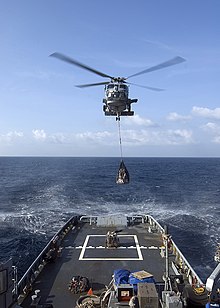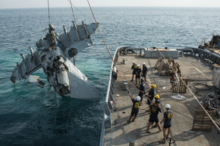Five ships of the United States Navy have been named Catawba, after the Catawba River of North Carolina.
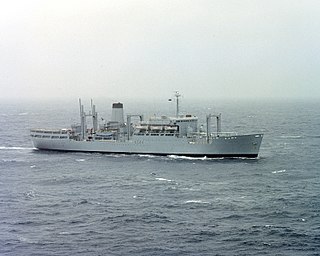
RFA Stromness (A344) was a fleet stores ship which served the Royal Fleet Auxiliary until sold to the U.S. Navy's Military Sealift Command in 1983. While in the service of British forces, it saw service in the Falklands War. After the sale to the United States, it was renamed USNS Saturn (T-AFS-10) and acted as a combat stores ship until it was deactivated in 2009; it was able to supply two other ships at once. In 2010, it was sunk in an exercise by the U.S. Carrier Strike Group Two off the coast of North Carolina.
Six ships of the United States Navy have borne the name USS Powhatan or USNS Powhatan, named in honor of Powhatan (1550–1618), an Indian chief in tidewater Virginia; the father of Pocahontas.

USS Jesse L. Brown (DE/FF/FFT-1089) was a Knox-class frigate of the United States Navy. She was named for Jesse L. Brown, the first African-American naval aviator in the U.S. Navy. The ship was eventually decommissioned and sold to the Egyptian Navy and was renamed Damiyat (F961). The name is also transliterated as Damyat and Damietta by some sources.

USNS Salvor (T-ARS-52) is a Safeguard-class rescue and salvage ship, the second United States Navy ship of that name.

USS Cree (AT/ATF-84), a Cherokee-class fleet tug, was a ship of the United States Navy named for the Cree, an indigenous people of North America whose people range from the Rocky Mountains to the Atlantic Ocean.

USS Lipan (AT-85) was a Navajo-class fleet tug constructed for the United States Navy during World War II. Her purpose was to aid ships, usually by towing, on the high seas or in combat or post-combat areas, plus "other duties as assigned." She served in the Pacific Ocean during World War II and the Korean War. She was awarded two battle stars for World War II and four battle stars for the Korean War.

USS Salinan (ATF-161) was an Achomawi-class tug built for the United States Navy during World War II. Named after the Salinan peoples, she was the only U.S. Naval vessel to bear the name.

USNS Apache (T-ATF-172) was a U.S. Navy Powhatan-class fleet ocean tugboat that was operated by the Military Sealift Command (MSC) from 1981 to 2022. She spent the bulk of her career in the Atlantic and Mediterranean.
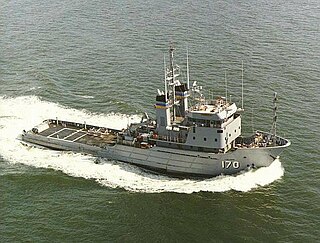
USNS Mohawk (T-ATF-170) was a United States Navy Powhatan-class tugboat operated by the Military Sealift Command from 1980 to 2005.

USS Navasota (AO-106) was an Ashtabula-class replenishment oiler that served in the U.S. Navy from 1946 to 1973, then transferred to the Military Sealift Command to continue service as United States Naval Ship USNS Navasota (T-AO-106) until taken out of service in 1992. Navasota was sold for scrapping in 1995. She was the only U.S. Navy ship to bear the name Navasota.
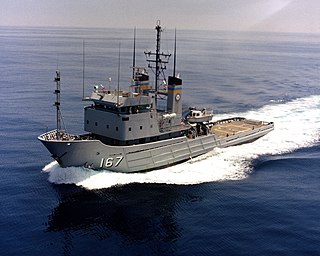
USNS Narragansett (T-ATF-167) is a Powhatan-class fleet ocean tugboat of the US Navy. She was launched in 1979 and inactivated in 1999, but has since been employed in a number of roles. She is still in service as of 2023 as a training support vessel for Carrier Strike Group 4.

USNS Navajo (T-ATF-169) was a United States Navy Powhatan-class tugboat operated by the Military Sealift Command which was in service from 1980 to 2016. She spent the bulk of her career in the Pacific and is currently moored in Pearl Harbor, awaiting disposal.

USNS Powhatan (T-ATF-166) was the lead ship of the United States Navy Powhatan-class fleet ocean tugboats. She was in service with the U.S. Navy from 1979 to 1999, and then was leased to a private towing and salvage company. At the end of the lease in 2008, the ship was sold to the Turkish Navy which recommissioned her as TCG Inebolu.

USNS Sioux (T-ATF-171) was a United States Navy Powhatan-class tugboat operated by the Military Sealift Command (MSC). She was in service from 1981 to 2021 and spent the bulk of this time supporting the Pacific Fleet.

The Powhatan class of fleet ocean tugs consists of seven ships built for the United States Navy, and operated by the Military Sealift Command (MSC). The lead ship of the class was launched in 1978 and the last ship in MSC service will be deactivated in 2023. During their service life, the Powhatan's were the most powerful tugs owned by the Navy.
The Naval Fleet Auxiliary Force is a division of the US Navy. The 42 ships of the Military Sealift Command's Naval Fleet Auxiliary Force are the supply lines to U.S. Navy ships at sea. These ships provide virtually everything that Navy ships need, including fuel, food, ordnance, spare parts, mail and other supplies. NFAF ships enable the Navy fleet to remain at sea, on station and combat ready for extended periods of time. NFAF ships also conduct towing, rescue and salvage operations or serve as floating medical facilities. All NFAF ships are government owned and crewed by civil service mariners. Some of the ships also have a small contingent of Navy personnel aboard for operations support, supply coordination and helicopter operations.

The Navajo class is a class of Towing, Salvage and Rescue Ships for the Military Sealift Command of the United States Navy. They were ordered in 2017 as the planned replacement for the aging Safeguard-class rescue and salvage ships and Powhatan-class tugboats. A total of ten ships of the class have been planned and none have yet to be put in service.

USS Lewis B. Puller (ESB-3), is the first purpose-built expeditionary mobile base vessel for the United States Navy, and the second ship to be named in honor of Chesty Puller. The lead ship in her class of expeditionary mobile bases, she is also a sub-variant of the Montford Point-class expeditionary transfer docks. Lewis B. Puller replaced USS Ponce with the U.S. Fifth Fleet in the Persian Gulf in fall 2017.

